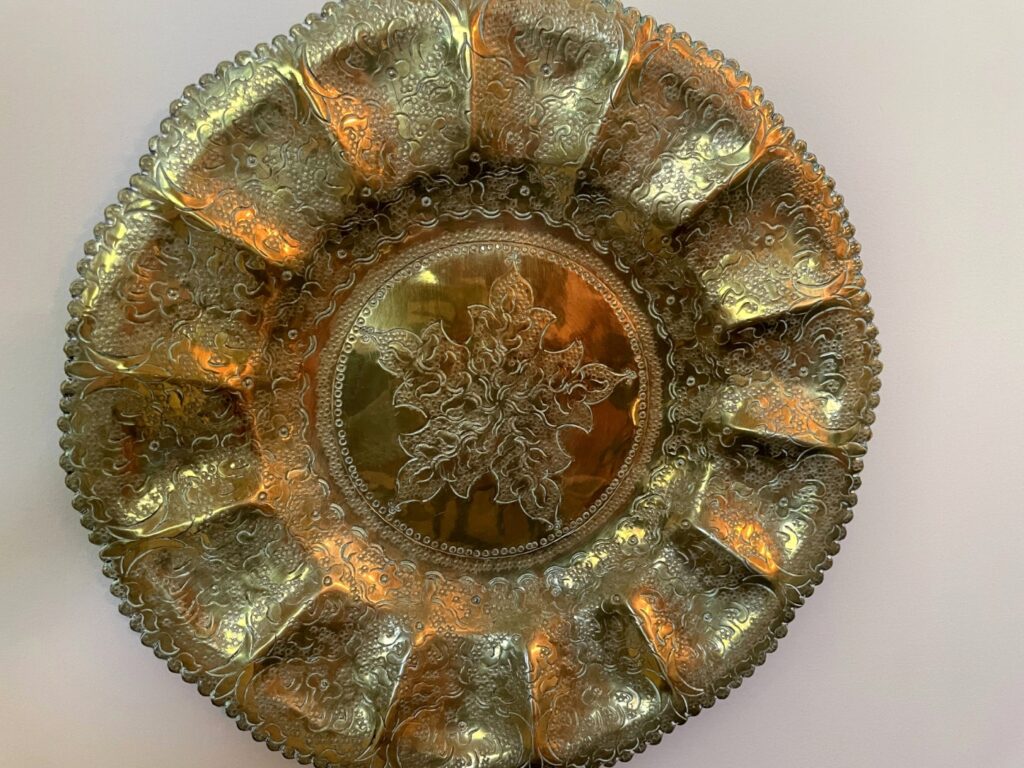
Today’s story begins in a crowded marketplace in New Delhi, India, in the mid-’60s. Martha Ramsay had just bought three round, handcrafted brass trays and a basket of peaches.
“I was walking through the market carrying these heavy trays along with the fruit, when I heard a hiss in my ear,” she wrote in an online post. “I turned and saw a king cobra sitting on a man’s shoulder right next to me.”
She threw the peaches and trays into the air and ran for her life. “The man ran, too! It was chaos,” recalls Ramsay, who permitted me to share her story. When the scene calmed, she went back to retrieve her trays and fruit.
Nearly 60 years later, the brass trays hang in her home, a reminder of that harrowing encounter. To her three adult sons, however, the trays meant nothing. They might as well have been trinkets picked up at Pier One Imports — until Ramsay posted a photo and the tale on Artifcts.com, a new online platform for those who want to preserve the stories behind their stuff for future generations.
Part family museum, part storage locker, part scrapbook, Artifcts lets you preserve keepsakes in a shareable digital collection. The truly motivated can upload audio or video files, too.
Just think of all the times your parents or grandparents told you stories, and you didn’t pay attention.
“We end the mess and solve the mystery,” said Artifcts co-founder Heather Nickerson.
She and fellow co-founder Ellen Goodwin, both former CIA agents (and you thought the story couldn’t get any better) launched the platform last August. Today, nearly 900 members have uploaded more than 3,000 items at costs ranging from free (upload five artifacts) to $89 (unlimited items for a year). That’s a lot cheaper than a storage unit.
“The trays are a perfect example of how memories linked to objects help define a life,” Nickerson said, adding that once Ramsay’s sons learned the cobra story, they each wanted a tray.
Naturally, I had a few questions for Nickerson.
Q. Why is Artifcts missing an A?
A. We wanted to redefine artifacts as anything that has meaning or value, and because to have an intellectual property approved by the U.S. Patent Office, you cannot name it with a common everyday word, so we made one up.
Q. How did two nice CIA agents like you end up launching a digital storage place like this?
A. We’re not your typical entrepreneurs. Ellen and I both worked as intelligence analysts for the CIA for ten years. Like most CIA types, we are driven and share an insane desire to gather data.
Q. Where did the idea come from?
A. My mom died unexpectedly in 2016 at age 65. She had an estate plan, so her financial affairs were in order, thankfully, but her stuff was overwhelming. I remember sitting on the floor of her closet in tears. I wanted to hold onto what mattered, but I had no way of knowing what did. Some people put sticky notes on the backs of keepsakes saying where they came from or which child should get it, but the stories don’t convey. I figured there must be a better way.
Q. What are your members virtually saving?
A. Stuff they don’t want around the house but still want to remember: a special piece of kid art, an old letterman jacket. They also upload images of items they want to keep but chronicle, such as jewelry, family recipes alongside a picture of the dish and the cook, and holiday decor.
Q. Does this help folks declutter?
A. Half the time we see that once someone has stored an item and preserved its meaning online, they let it go. Others upload pictures and descriptions of items they plan to pass down. Some use the platform to send files to their insurance companies or to link to their estate plans.
Related Articles
What you need to know about choosing appropriate plants for your climate zone
What to know about the fiery blooms of this week’s hummingbird-friendly California native
This colorfully blooming plant thrives in hot weather and needs little water
How to cook with garden and windowsill herbs this summer
What you need to know about air plants, or Tillandsias, the popular category of bromeliad
Q. Who can see the collection?
A. Because of our CIA background, we understand the importance of privacy. When members sign on, their default setting is private. We encourage them to provide contact information for at least two legacy contacts to ensure their collection isn’t lost to cyberspace. Beyond that, they can make the collection visible to whomever they want.
Q. What if something happens to you or Ellen?
A. We are not planning to go anywhere for a long time, but we do have a strategic plan, a board of advisors and resources set aside to ensure that Artifcts can keep growing and going past us.
Marni Jameson is the author of six home and lifestyle books, including “Downsizing the Family Home – What to Save, What to Let Go.” Contact her at www.marnijameson.com.
